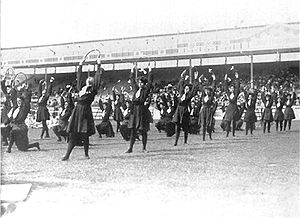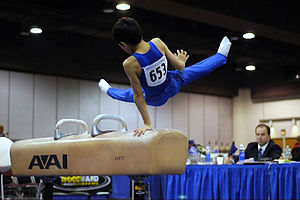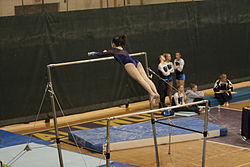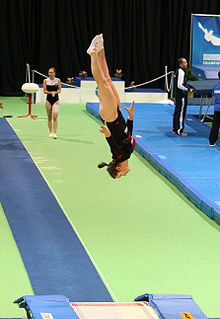- Gymnastics
-
This article is about the general sport. For a specific form of gymnastics, see Gymnastics (disambiguation).
Gymnastics is a sport involving performance of exercises requiring physical strength, flexibility, agility, coordination, and balance. Internationally, all of the gymnastic sports are governed by the Fédération Internationale de Gymnastique (FIG) with each country having its own national governing body affiliated to FIG. Competitive Artistic gymnastics is the best known of the gymnastic sports. It typically involves the women's events of uneven parallel bars, balance beam, floor exercise, and vault. Men's events include floor exercise, pommel horse, still rings, vault, parallel bars, and high bar. Gymnastics evolved from exercises used by the ancient Greeks, that included skills for mounting and dismounting a horse, and from circus performance skills.
Other gymnastic sports include rhythmic gymnastics, the various trampolining sports, aerobic and acrobatic gymnastics.
Participants can include children as young as five years old doing kindergym and children's gymnastics, recreational gymnasts of ages 5 and up, competitive gymnasts at varying levels of skill, and world class athletes.
Contents
Etymology
The word derives from the Greek γυμναστική (gymnastike), fem. of γυμναστικός (gymnastikos), "fond of athletic exercises",[1] from γυμνάσια (gymnasia), "exercise"[2] and that from γυμνός (gymnos), "naked",[3] because athletes exercised and competed without clothing.
History
 1908 Summer Olympics in London: Display of the British women's gymnastics team
1908 Summer Olympics in London: Display of the British women's gymnastics team
Exercises of the ancient Greeks began with athletic feats performed by each individual according to his own notion. The youth were encouraged to combine amusement with exercise. In time, this kind of exercise was incorporated into a system that figured prominently in the state regulations for education. In fact, the period for exercise or gymnastics was equal to the time spent on art and music combined.[4] All Greek cities had a gymnasium, a courtyard for jumping, running, and wrestling.
As the Roman Empire ascended, the Greek gymnastics gave way to gymnastics whose purpose was military training. The Romans, for example, introduced the wooden horse.
In 393 AD the Emperor Theodosius abolished the Olympic Games, which by then had become corrupt and gymnastics, along with other sports, declined. For centuries, gymnastics was all but forgotten.[5]
In the fifteenth century, Girolamo Mercuriale from Forlì (Italy) wrote De Arte Gymnastica, that brought together his study of the attitudes of the ancients toward diet, exercise and hygiene, and the use of natural methods for the cure of disease. De Arte Gymnastica also explained the principles of physical therapy and is considered the first book on sports medicine.
In the late eighteenth and early nineteenth century Germany, three pioneer physical educators – Johann Friedrich GutsMuths (1759–1839) and Friedrich Ludwig Jahn (1778–1852) – created exercises for boys and young men on apparatus they had designed that ultimately led to what is considered modern gymnastics. Don Francisco Amoros y Ondeano, marquis de Sotelo, is born on february 19th 1770 in Valence and died on august 8th 1848 in Paris he was au spanish colonel, the firs one to introduce educative gymnastic in France. He created the firs gymnasium military and civil in Paris. In particular, Jahn crafted early models of the horizontal bar, the parallel bars (from a horizontal ladder with the rungs removed), and the vaulting horse.[5]
The Federation of International Gymnastics (FIG) was founded in Liege in 1881.[6] By the end of the nineteenth century, men's gymnastics competition was popular enough to be included in the first "modern" Olympic Games in 1896. From then on until the early 1950s, both national and international competitions involved a changing variety of exercises gathered under the rubric, gymnastics, that would seem strange to today's audiences and that included for example, synchronized team floor calisthenics, rope climbing, high jumping, running, horizontal ladder. During the 1920s, women organized and participated in gymnastics events. The first women's Olympic competition was primitive, for it involved only synchronized calisthenics, was held at the 1928 Games, in Amsterdam.
By 1954, Olympic Games apparatus and events for both men and women had been standardized in modern format, and uniform grading structures (including a point system from 1 to 15) had been agreed upon. At this time, Soviet gymnasts astounded the world with highly disciplined and difficult performances, setting a precedent that continues. The new medium of television helped publicize and initiate a modern age of gymnastics. Both men's and women's gymnastics now attract considerable international interest, and excellent gymnasts can be found on every continent. Nadia Comăneci received the first perfect score, at the 1976 Summer Olympics held in Montreal, Canada. She was coached in Romania by the Romanian coach, (Hungarian ethnicity), Béla Károlyi. Comaneci scored four of her perfect tens on the uneven bars, two on the balance beam and one in the floor exercise.[7] Even with Nadia's perfect scores, the Romanians lost the gold medal to the Soviet Union. Nevertheless, Comaneci became an Olympic icon.
In 2006, a new points system for Artistic gymnastics was put into play. With an A Score (or D score) being the difficulty score, which as of 2009 is based on the top 8 high scoring elements in a routine (excluding Vault). The B Score (or E Score), is the score for execution, and is given for how well the skills are performed.[8]
Forms
Artistic gymnastics
Main article: Artistic gymnasticsArtistic gymnastics is usually divided into Men's and Women's Gymnastics. Typically men compete on six events: Floor Exercise, Pommel Horse, Still Rings, Vault, Parallel Bars, and High Bar, while women compete on four: Vault, Uneven Bars, Balance Beam, and Floor Exercise. In some countries, women at one time competed on the rings, high bar, and parallel bars (for example, in the 1950s in the USSR). Though routines performed on each event may be short, they are physically exhausting and push the gymnast's strength, flexibility, endurance and awareness to the limit.
In 2006, FIG introduced a new points system for Artistic gymnastics in which scores are no longer limited to 10 points. The system is used in the US for elite level competition.[8]
Events for women
- Vault
- In the vaulting events gymnasts sprint down a 25 metres (82 ft) runway, jump onto a beatboard or springboard (run/ take-off segment), land momentarily, generally inverted on the hands on the vaulting horse or vaulting table (pre flight segment), then spring off of this platform to a two footed landing (post flight segment). Every gymnast starts at a different point on the vault runway depending on their height and strength. The post flight segment may include one or more multiple saltos or somersaults, and/or twisting movements. Round-off entry vaults are the most common vaults. In vaults with roundoff entries, gymnasts "round-off" so hands are on the runway while the feet land on the springboard (beatboard). From the roundoff position the gymnast travels backwards as in a backhandspring so that the hands land on the vaulting platform (horse). She then blocks off the vaulting platform into various twisting and somersaulting combinations. The post flight segment brings the gymnast to her feet.
- In 2001, the traditional vaulting horse was replaced with a new apparatus, sometimes known as a tongue or table. The new apparatus is more stable, wider, and longer than the older vaulting horse—approximately 1m in length and 1m in width—gives gymnasts a larger blocking surface, and is therefore safer than the old vaulting horse. With the addition of this new, safer vaulting table, gymnasts are attempting more difficult and dangerous vaults.[9]
- Uneven Bars
- On the uneven bars (also known as asymmetric bars, UK), the gymnast performs a routine on two horizontal bars set at different heights. These bars are made of fiberglass covered in wood laminate, to prevent them from breaking. In the past, bars were made of wood, but the bars were prone to breaking, providing an incentive to switch to newer technologies. The width of the bars may be adjusted. Gymnasts perform swinging, circling, transitional, and release moves, that may pass over, under, and between the two bars. Movements may pass through the handstand. Gymnasts often mount the Uneven Bars using a springboard.
 Daniele Hypólito at the 2007 Pan Am Games on Beam.
Daniele Hypólito at the 2007 Pan Am Games on Beam.
- Balance Beam
- The gymnast performs a choreographed routine up to 90 seconds in length consisting of leaps, acrobatic skills, somersaults, turns and dance elements on a padded, and sprung beam. The beam is 125 centimetres (4 ft 1 in) from the ground, 500 centimetres (16 ft 5 in) long, and 10 centimetres (3.9 in) wide.[10] The event requires, in particular, balance, flexibility and strength.
- Floor
- In the past, the Floor Exercise event was executed on the bare floor or mats such as wrestling mats. Today, the floor event occurs on a carpeted 12m × 12m square, usually consisting of hard foam over a layer of plywood, which is supported by springs or foam blocks generally called a "spring" floor. This provides a firm surface that provides extra bounce or spring when compressed, allowing gymnasts to achieve extra height and a softer landing than would be possible on a standard floor. Gymnasts perform a choreographed routine up to 90 seconds in the Floor Exercise event. They must choose an accompanying music piece. In some gymnastic associations such as United States Association of Gymnastic Clubs (USAIGC), gymnasts are allowed to have vocals in their music[11] but USA Gymnastics competitions a large deduction is taken from the score for having vocals in the music.[12], The routine should consist of tumbling lines, series of jumps, dance elements, acrobatic skills, and turns, or piviots, on one foot. A gymnast can perform up to four tumbling lines that include at least one flight element without hand support. Each level of gymnastics requires the athlete to perform a different number of tumbling passes, in level 7 you are required to do 2–3 and in levels 8–10 at least 3–4 tumbling passes are required.[13]
Scoring: A gymnast's score comes from deductions taken from their start value. The start value of a routine is calculated based on the difficulty of the elements the gymnast attempts and whether or not the gymnast meets composition requirements. The composition requirements are different for each apparatus. This score is called the D score.[14] Deductions in execution and artistry are taken from 10.0. This score is called the E score.[15] The final score is calculated by taking deductions from the E score, and adding the result to the D score.[16] And since 2007, the scoring system has changed by adding bonus plus the execution and then adding those two together to get the final score.
Events for men
- Floor
- Male gymnasts also perform on a 12m. by 12m. spring floor. A series of tumbling passes are performed to demonstrate flexibility, strength, and balance. The gymnast must also show strength skills, including circles, scales, and press handstands. Men's floor routines usually have four passes that will total between 60–70 seconds and are performed without music, unlike the women's event. Rules require that male gymnasts touch each corner of the floor at least once during their routine.
 A boy on the pommel horse
A boy on the pommel horse
- Pommel Horse
- A typical pommel horse exercise involves both single leg and double leg work. Single leg skills are generally found in the form of scissors, an element often done on the pommels. Double leg work however, is the main staple of this event. The gymnast swings both legs in a circular motion (clockwise or counterclockwise depending on preference) and performs such skills on all parts of the apparatus. To make the exercise more challenging, gymnasts will often include variations on a typical circling skill by turning (moores and spindles) or by straddling their legs (Flares). Routines end when the gymnast performs a dismount, either by swinging his body over the horse, or landing after a handstand.
- Still Rings
- The rings are suspended on wire cable from a point 5.75 metres from the floor, and adjusted in height so the gymnast has room to hang freely and swing. He must perform a routine demonstrating balance, strength, power, and dynamic motion while preventing the rings themselves from swinging. At least one static strength move is required, but some gymnasts may include two or three. A routine should have a dismount equal in difficulty to the difficulty of the routine as a whole.
- Vault
- Gymnasts sprint down a runway, which is a maximum of 25 metres in length, before hurdling onto a spring board. The body position is maintained while "punching" (blocking using only a shoulder movement) the vaulting platform. The gymnast then rotates to a standing position. In advanced gymnastics, multiple twists and somersaults may be added before landing. Successful vaults depend on the speed of the run, the length of the hurdle, the power the gymnast generates from the legs and shoulder girdle, the kinesthetic awareness in the air, and the speed of rotation in the case of more difficult and complex vaults.
- Parallel Bars
- Men perform on two bars slightly further than a shoulder's width apart and usually 1.75m high while executing a series of swings, balances, and releases that require great strength and coordination.
- High Bar
- A 2.8 cm thick steel or fiberglass bar raised 2.5m above the landing area is all the gymnast has to hold onto as he performs giants (revolutions around the bar), release skills, twists, and changes of direction. By using all of the momentum from giants and then releasing at the proper point, enough height can be achieved for spectacular dismounts, such as a triple-back salto. Leather grips are usually used to help maintain a grip on the bar.
As with the women, male gymnasts are also judged on all of their events, for their execution, degree of difficulty, and overall presentation skills.
Rhythmic gymnastics
Main article: Rhythmic gymnasticsOnly women compete in rhythmic gymnastics although there is a new version of this discipline for men being pioneered in Japan, see Men's rhythmic gymnastics. This is a sport that combines elements of ballet, gymnastics, dance, and apparatus manipulation. The sport involves the performance of five separate routines with the use of five apparatus—ball, ribbon, hoop, clubs, rope—on a floor area, with a much greater emphasis on the aesthetic rather than the acrobatic. There are also group routines consisting of 5 gymnasts and 5 apparatuses of their choice. Rhythmic routines are scored out of a possible 30 points; the score for artistry (choreography and music) is averaged with the score for difficulty of the moves and then added to the score for execution.[17]
International competitions are split between Juniors, under sixteen by their year of birth; and Seniors, for women sixteen and over again by their year of birth. Gymnasts in Russia and Europe typically start training at a very young age and those at their peak are typically in their late teens (15–19) or early twenties. The largest events in the sport are the Olympic Games, World Championships, and Grand-Prix Tournaments.
Trampolining and tumbling
Main articles: Trampolining and Tumbling (gymnastics)Trampolining and tumbling consists of four events, individual, synchronized, double mini and tumbling (also known as power tumbling). Since 2000, individual trampoline has been included in the Olympic Games. Individual routines in trampolining involve a build-up phase during which the gymnast jumps repeatedly to achieve height, followed by a sequence of ten leaps without pauses during which the gymnast performs a sequence of aerial skills. Routines are marked out of a maximum score of 10 points. Additional points (with no maximum at the highest levels of competition) can be earned depending on the difficulty of the moves and the length of time taken to complete the ten skills which is an indication of the average height of the jumps. In high level competitions, there are two preliminary routines, one which has only two moves scored for difficulty and one where the athlete is free to perform any routine. This is followed by a final routine which is optional. Some competitions restart the score from zero for the finals, other add the final score to the preliminary results. Synchronized trampoline is similar except that both competitors must perform the routine together and marks are awarded for synchronicity as well as the form and difficulty of the moves. Double mini trampoline involves a smaller trampoline with a run-up, two moves are performed for preliminaries and two more for finals. Moves cannot be repeated and the scores are marked in a similar manner to individual trampoline. In tumbling, athletes perform an explosive series of flips and twists down a sprung tumbling track. Scoring is similar to trampolining.
Acrobatic gymnastics
Main article: Acrobatic gymnasticsAcrobatic gymnastics (formerly Sports Acrobatics), often referred to as acro if involved with the sport, acrobatic sports or simply sports acro, is a group gymnastic discipline for both men and women. Acrobats in groups of two, three and four perform routines with the heads, hands and feet of their partners. They may, subject to regulations (e.g. no lyrics), pick their own music.
Throughout the world, there at three FIG levels: Age group (Age 11-16), Junior(12-19) and Senior (15+), which are used in the World Championships and many other events around the world, including European Championships and World Games. All levels require a balance and dynamic routine, Junior and Seniors are also required to perform a final (combined) routine.
Currently acrobatic gymnastics is marked out of 30.00 (can be higher at Senior FIG level based on difficulty):
10.00 for routine difficulty, (valued from the tables of difficulties)
10.00 For technical performance, (how well the skills are executed)
10.00 For Artistry, (the overall performance of the routine, namely choreography)
TeamGym
Team Gym or Gymnastics for All has it origins in earliest times.These days, although teams can compete the sport itself was developed to enhance fitness and health in the participants and is accessible to anyone of any age. In 1984 Gymnastics for All was officially recognized first as a Sport Program by the FIG (International Gymnastic Federation), and subsequently by national gymnastic federations world wide with participants that now number 30 million.[18]
- Floor Programme
- All members of the Team take part in the floor program, composed of a mixture of dance, flexibility and skill. The routine has to be skillfully choreographed and the judges look out for changes in shape. There needs to be at least two spins, two balances and two section elements. These section elememts are bodywaves for women's teams, power elements for men's teams and lifts for mixed teams. Floor routines are performed to music.
- Trampette
- Here a trampette is used. There are two components of this; Vault and the Trampette on its own. There has to be three runs in total. At least one of these runs has to be a vault run. Another run has to include all the gymnasts doing the same move. This is generally the first run. This is also performed to music.
- Tumbling
- Again, here there are three runs (rounds) involved. One of which has to include all six gymnasts doing a forwards series. Another run also has to include the gymnasts completing the same move. Each series must have at least three different acrobatic elements.[19]
Display gymnastics
General gymnastics enables people of all ages and abilities to participate in performance groups of 6 to more than 150 athletes. They perform synchronized, choreographed routines. Troupes may be all one gender or mixed. There are no age divisions in general gymnastics. The largest general gymnastics exhibition is the quadrennial World Gymnaestrada which was first held in 1939.
Aerobic gymnastics
Main article: Aerobic gymnasticsAerobic gymnastics (formally Sport Aerobics) involves the performance of routines by individuals, pairs, trios or groups up to 6 people, emphasizing strength, flexibility, and aerobic fitness rather than acrobatic or balance skills. Routines are performed for all individuals on a 7x7m floor and also for 12–14 and 15–17 trios and mixed pairs. From 2009, all senior trios and mixed pairs were required to be on the larger floor (10x10m), all groups also perform on this floor. Routines generally last 60–90 seconds depending on age of participant and routine category.
Former apparatus and events
Rope (rhythmic gymnastics)
Starting in 2011, the rhythmic apparatus rope will be removed from all FIG events and clubs will be returned to the competition. FIG has a policy of only using four of the five pieces of apparatus and changes them for different Olympic cycles. This will affect World Cups, World Championships, and Olympics.
Rope climb
Main article: Rope climbingGenerally, competitors climbed either a 6m (6.1m = 20 ft in USA) or an 8m (7.6m = 25 ft in USA), 38mm (1.5") diameter natural fiber rope for speed, starting from a seated position on the floor and using only the hands and arms. Kicking the legs in a kind of "stride" was normally permitted. Many gymnasts can do this in the straddle or pike position, which eliminates the help generated from the legs.
Flying rings
Main article: Flying ringsFlying rings was an event similar to still rings, but with the performer executing a series of stunts while swinging. It was a gymnastic event sanctioned by both the NCAA and the AAU until the early 1960s.
Popular culture
Film
See also
- NCAA Men's Gymnastics championship (US)
- NCAA Women's Gymnastics championship (US)
- Turners
- Majorettes
- Cheerleading
References
- ^ Gymnastikos, Henry George Liddell, Robert Scott, A Greek-English Lexicon, at Perseus
- ^ Gymnasia, Henry George Liddell, Robert Scott, A Greek-English Lexicon, at Perseus
- ^ Gymnos, Henry George Liddell, Robert Scott, A Greek-English Lexicon, at Perseus
- ^
 "Gymnastics, History of". Encyclopedia Americana. 1920.
"Gymnastics, History of". Encyclopedia Americana. 1920. - ^ a b Goodbody, John (1982). The Illustrated History of Gymnastics. London: Stanley Paul & Co.. ISBN 0091433509.
- ^ Artistic Gymnastics History at fig-gymnastics.com
- ^ Fimrite, Ron (1996-07-25). "Practice made her perfect". sportsillustrated.cnn.com. http://sportsillustrated.cnn.com/events/1996/olympics/daily/july25/flashback.html.
- ^ a b http://www.usa-gymnastics.org/events/pages/fig_scoring.php
- ^ "Vault: Everything You Need to know about Vault". http://gymnastics.about.com/od/gymnasticsapparatus/p/watchingvault.htm. Retrieved 2009-10-04.
- ^ "Apparatus Norms" (PDF). FIG. p. II/51. http://figdocs.lx2.sportcentric.com/external/serve.php?document=1540. Retrieved 2009-10-04.
- ^ http://www.usaigc.com/tech_cont.cfm?content=Women’s&id=25
- ^ USA Gymnastics
- ^ "WAG Code of Points 2009–2012" (PDF). FIG. p. 29. http://figdocs.lx2.sportcentric.com/external/serve.php?document=1258. Retrieved 2009-10-02.
- ^ "WAG Code of Points 2009–2012" (PDF). FIG. p. 11. http://figdocs.lx2.sportcentric.com/external/serve.php?document=1258. Retrieved 2009-10-02.
- ^ "WAG Code of Points 2009–2012" (PDF). FIG. p. 13. http://figdocs.lx2.sportcentric.com/external/serve.php?document=1258. Retrieved 2009-10-02.
- ^ "WAG Code of Points 2009–2012" (PDF). FIG. p. 14. http://figdocs.lx2.sportcentric.com/external/serve.php?document=1258. Retrieved 2009-10-02.
- ^ Fédération Internationale de Gymnastique, Code of Points – Rhythmic Gymnastics 2009–2012
- ^ http://usa-gymnastics.org/pages/group/pages/gymnastics_101.html
- ^ TeamGym, British Gymnastics
External links
 Texts on Wikisource:
Texts on Wikisource:
- "Gymnastics". New International Encyclopedia. 1905.
- Chisholm, Hugh, ed (1911). "Gymnastics and Gymnasium". Encyclopædia Britannica (11th ed.). Cambridge University Press.
- "Gymnastics". Collier's New Encyclopedia. 1921.
Olympic sports Summer sports Archery • Athletics • Badminton • Basketball • Boxing • Canoeing • Cycling • Diving • Equestrian • Field hockey • Fencing • Football • Gymnastics • Handball • Judo • Modern pentathlon • Rowing • Sailing • Shooting • Swimming • Synchronized swimming • Table tennis • Taekwondo • Tennis • Triathlon • Volleyball • Water polo • Weightlifting • Greco-Roman Wrestling
Winter sports Former Olympic sports Baseball • Basque pelota • Cricket • Croquet • Golf • Jeu de paume • Lacrosse • Polo • Rackets • Roque • Rugby union • Softball • Tug of war • Water motorsports
Part of the 2016 program See also: Paralympic sportsCategories:- Gymnastics
- Olympic sports
- Individual sports
- Sports rules and regulations
- Greek loanwords
Wikimedia Foundation. 2010.






